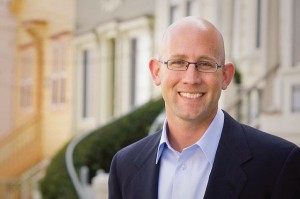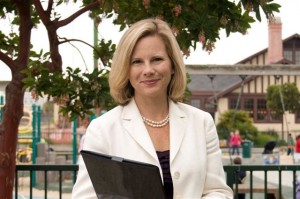Name: Jane Kim
Age: 33
Occupation: Civil Rights Attorney
District: 6
URL for website: www.janekim.org
Neighborhood You Live In: Civic Center
Date Questionnaire Returned: September 7, 2010
1. How often do you rely on Muni to get you around town? If not, what do you use instead? What would make it easier for you to choose Muni over other forms of transportation?
I rely on MUNI almost every day to get around town– to work, meetings, shopping and running errands. District 6 is the district with the densest concentration of Muni lines in the city. To increase ridership on MUNI, I support most of the recommendations from the Transit Effectiveness Project, especially the proposals to expedite boarding and speed up travel. I support the BRT proposals for Van Ness and Geary and would like to see BRT extended into the north Mission. I would also like to see greater priority of Muni on Market Street, the city’s most important transit street. I support the Central Subway, as well as the extension of Caltrain to downtown and the development of the Transbay Terminal as the SF terminus for high-speed rail.
2. What are the primary concerns of Muni’s owners (aka riders) about transportation and Muni in your District?
The primary concern of riders is reliability and speed. Currently, MUNI averages at 8.1 MPH and I hear many complaints about the timeliness of MUNI lines and its speed to get to work, social outings and run errands.
3. As a Supervisor, you will serve on the Board of the San Francisco County Transportation Authority. What is the role of the SFCTA, and what would you set as priorities for the agency in the next 4 years?
The role of the SFCTA, legally, is threefold: administer the 1/2-cent sales tax, serve as the congestion management agency that gives it certain state-determined powers, and act as the grants manager for Air District grants. Generally, these fall into the category of administrator of a substantial portion of transportation money (mostly capital), and in that role they engage in the establishment and enforcement of some transportation standards.
Some say that the SFCTA has overstepped its traditional role in getting involved in the actual planning for many transportation projects. Others counter that the SFCTA has more planning capacity than the MTA. I do support the Tenderloin Safe Streets plan and support its recommendations for calming the traffic on more streets.
In general, I believe that the SFCTA should set long-term planning that is complimentary to MTA’s operational plans, and I believe SFCTA should prioritize capital funding for MUNI improvements.
4. Difficult decisions often have to be made regarding transportation in San Francisco. Sometimes a well-researched project may have loud, angry opponents, or a popular project may not be the best for City residents and for San Francisco’s transportation infrastructure.
How would you make a decision under these kinds of circumstances? (Feel free to cite a similar situation from your past experience as an example – it doesn’t have to be transit related)
Having served on the San Francisco Board of Education, I am quite familiar with making hard decisions in face of loud, angry opposition or active, popular support. Most recently, I chaired the Student Assignment Redesign Process, one of the most controversial issues in the school district this past decade. I chaired a strong process which brought together many education and planning experts, collected important data, coordinated hundreds of community meetings and eventually brought consensus amongst seven Board members around one policy recommendation. I have also made tough decisions to co-locate schools and programs or end programs despite opposition/support because based on research, data and finances, they were the right decisions to make for the District as a whole.
I will support well-researched, good projects such as the Geary BRT plan despite vocal opposition if I feel that it is best for the city and our budget as a whole.
5. What is the Fix Muni Now charter amendment? Do you support it? (Y/N) Why or why not?
I support Proposition G. Operators have a tough job in this city and as a policy, I believe they should be paid well with benefits. However I believe that pay, benefits and work rules should be negotiated through collective bargaining and not set by the city charter. The core of the Fix Muni Now is to require Muni drivers to participate in collective bargaining. Currently, they are the only unionized city employees who are not currently engaged in collective bargaining. We also need to reform the MTA, not just MUNI operators’ over-time and pension – I support Supervisors and the Mayor sharing appointments ensuring greater representation our commissions.
6. One (of many) causes for Muni’s perennial budget woes was the illegal seizure of state gas tax money by Governor Schwarzenegger and the Legislature. This has left a large hole in Muni’s income (as well as every transit agency in CA).
How would you make up this gap in Muni revenue? Would you support
– a local funding source or sources (fees, taxes, or other type of revenue) to avoid future problems caused by the state?
– would you achieve savings through cuts to Muni’s budget, fare increases, etc.
– or, do you have other ideas on how to get Muni out of its annual ï¬nancial woes?
(You can choose more than one option, but just explain it clearly)
The rising cost of MUNI can no longer be offset by squeezing more revenue from the ridership. As Supervisor, I would pursue a variety of other strategies to improve and increase MUNI service from current levels, looking for advancements in management, public information, transparency, operations, and safety. If we are able to speed up MUNI from its current 8.1 MPH average with pre-boarding payment, the Van Ness and Geary BRT, and prioritized lanes for MUNI, and stop consolidation, we can increase service without increasing costs. There is also a substantial amount of savings to be had from reducing travel times.
For management, we need to be careful about the metrics that we use to hold MUNI accountable. For example, if on-time performance is the only metric, that can unintentionally skew toward results that are not entirely in the public interest (e.g. stops being skipped).
For operations, I would advocate for the prioritization of an approved upgraded control center, to address the current antiquated system.
7. Finally, tell us a story about a funny or unique experience you’ve had on Muni.
Last year, I broke up a fight on the 30 Stockton shortly after the infamous MUNI fight YouTube video. Similar story — crowded bus with students getting out of school, seniors, shoppers, etc — but definitely room for more people. I attempted to calm down two young students who were starting a fight with a third person — forced them to disembark on Market Street, tried to find out what schools they attended (as a School Board member). I left as the bus departed, thinking that I broke it up and they’d have to get on the next bus. As I turned around, I saw the bus leaving Market Street sluggishly, and then in typical MUNI fashion, a new rider opened the back door and the students ran back on. I don’t know if the fight continued– but it was a lesson that we need to get MUNI running faster!





